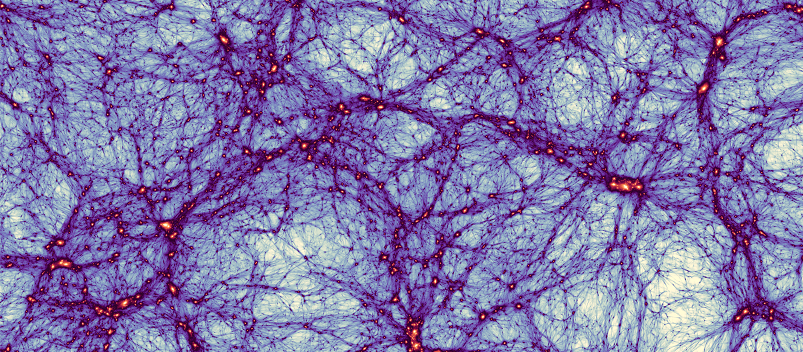Computational Cosmology
Understanding the origin of the structure and evolution of the Universe

This research area focuses on deepening our understanding of the cosmos by creating a new generation of computer models to be applied to some of the largest cosmological datasets worldwide. The final objective of this research activity is to develop a unified framework capable of directly predicting the spatial distribution of galaxies, clusters, filaments and cosmic voids as a function of fundamental properties of the Universe: dark energy, gravity on cosmological scales, and the presence of fundamental particles such as massive neutrinos.
Specific topics
- Development of N-body algorithms and simulations of the large-scale-structure of the Universe.
- Models for the formation and co-evolution of galaxies and black holes.
- Exploitation and analysis of large extra-galactic observational surveys.
- Cosmological probes of dark energy, dark matter, and gravity lensing.
Related publications
-
 1
The BACCO simulation project: biased tracers in real space
1
The BACCO simulation project: biased tracers in real space
M. Zennaro, R. E. Angulo, M. Pellejero-Ibanez, J. Stucker, S. Contreras, and G. Arico
Mon. Not. Roy. Astron. Soc. 524, 2407 (2023). -
 2
Consistent and simultaneous modelling of galaxy clustering and galaxy-galaxy lensing with subhalo abundance matching
2
Consistent and simultaneous modelling of galaxy clustering and galaxy-galaxy lensing with subhalo abundance matching
S. Contreras, R. E. Angulo, J. Chaves-Montero, S. D. M. White, and G. Arico
Mon. Not. Roy. Astron. Soc. 520, 489 (2023). -
 3
Measuring the evolution of intergalactic gas from z=0 to 5 using the kinematic Sunyaev-Zel'dovich effect
3
Measuring the evolution of intergalactic gas from z=0 to 5 using the kinematic Sunyaev-Zel'dovich effect
J. Chaves-Montero, C. Hernandez-Monteagudo, R. E. Angulo, and J. D. Emberson
Mon. Not. Roy. Astron. Soc. 503, 1798 (2021). -
 4
The BACCO simulation project: exploiting the full power of large-scale structure for cosmology
4
The BACCO simulation project: exploiting the full power of large-scale structure for cosmology
R. E. Angulo, M. Zennaro, S. Contreras, G. Arico, M. Pellejero-Ibanez, and J. Stucker
Mon. Not. Roy. Astron. Soc. 507, 5869 (2021). -
 5
High-resolution tomography for galaxy spectroscopic surveys with angular redshift fluctuations
5
High-resolution tomography for galaxy spectroscopic surveys with angular redshift fluctuations
L. Legrand, C. Hernandez-Monteagudo, M. Douspis, N. Aghanim, and R. E. Angulo
Astron. Astrophys. 646, (2021). -
 6
Modelling the large-scale mass density field of the universe as a function of cosmology and baryonic physics
6
Modelling the large-scale mass density field of the universe as a function of cosmology and baryonic physics
G. Arico, R. E. Angulo, C. Hernandez-Monteagudo, S. Contreras, M. Zennaro, M. Pellejero-Ibanez, and Y. Rosas-Guevara
Mon. Not. Roy. Astron. Soc. 495, 4800 (2020). -
 7
3 per cent-accurate predictions for the clustering of dark matter, haloes, and subhaloes, over a wide range of cosmologies and scales
7
3 per cent-accurate predictions for the clustering of dark matter, haloes, and subhaloes, over a wide range of cosmologies and scales
S. Contreras, R. E. Angulo, M. Zennaro, G. Arico, and M. Pellejero-Ibanez
Mon. Not. Roy. Astron. Soc. 499, 4905 (2020). -
 8
The bias of dark matter tracers: assessing the accuracy of mapping techniques
8
The bias of dark matter tracers: assessing the accuracy of mapping techniques
M. Pellejero-Ibanez, A. Balaguera-Antolinez, F. -S. Kitaura, R. E. Angulo, G. Yepes, C. -H. Chuang, G. Reyes-Peraza, M. Autefage, M. Vakili, and C. Zhao
Mon. Not. Roy. Astron. Soc. 493, 586 (2020). -
 9
Precision modelling of the matter power spectrum in a Planck-like universe
9
Precision modelling of the matter power spectrum in a Planck-like universe
R. E. Smith, and R. E. Angulo
Mon. Not. Roy. Astron. Soc. 486, 1448 (2019).
